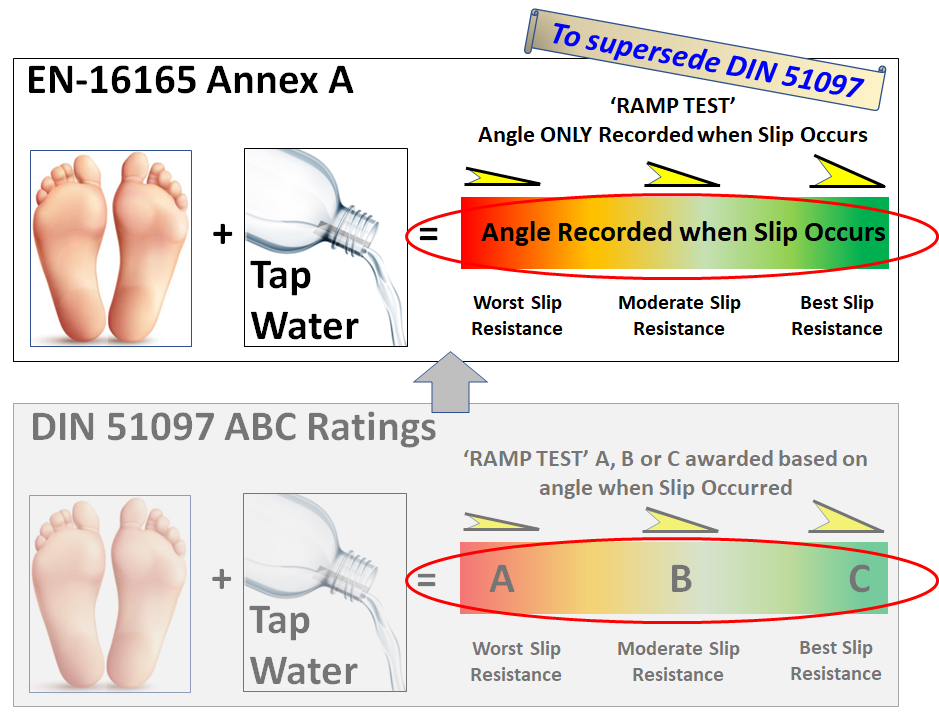Floor ABC Ratings (Bare Foot)
CAUTION - The ABC-Rating should NOT be used to specify GENERIC Floor Surfaces; the purpose of the test is for SPECIFIC floors under SPECIFIC Conditions. If you elect to use an ABC-Rated floor surface, then ALWAYS get it Floor Sample Pendulum Tested to ascertain its TRUE slip resistance in the environment you wish to place it
The Floor 'ABC-Rating' or 'Ramp Rating'
This is an angular value shown in degrees from a floor at horizontal determined via Ramp Testing. The purpose is to assist in evaluating / comparing the possible slip resistance potential of multiple floor surfaces that stay predominantly wet like swimming pools, jacuzzies and showers. The angular values arrived at via the Ramp Testing is conducted in accordance with EN-16165 Annex A, which 'broadly' determines the anti-slip properties. The steeper the test angle attained, the more likely it is the floor will be able to meet the next determining stage, which is carried out using the Pendulum Test, which is the only part of the test that is recognised by UK Law in Floor Slip Injury Claims
The UK Health and Safety Executive (HSE) has recommended a Pendulum Test Value of 36PTV is required on a horizontal floor surface when a Floor is WET or is CONTAMINATED as there is a 95% likelihood of floor slip and Slip Injury Claims exists when the floor is wet (Source data EN-16165). The target of 36 PTV must be increased by 1.75PTV for every one degree of Floor Slope
The Floor Pendulum Test Values or ‘PTV’ to determine the true Slip Resistance Potential of a floor is either conducted: -
- Either during an On-Site Pendulum Test
- Or as part of an Off-Site Floor Sample Test.
- See also Buying New Floors for further info.
Pendulum Testing of Floor Sample
ABC-Ratings & DIN 51097 | To be superseded by EN-16165
Under DIN 51097 the angle attained in the Ramp Test was awarded an 'A, B or C-Rating'. This (German) DIN Standard is in the process of being superseded by floor standard EN-16165 Annex A where only a single angular value is given and ABC-Ratings are no longer awarded.

The list below shows the ABC-Ratings under (to be superseded) DIN 51097; this data has been left on this page to give you an idea of Floor Slip Resistance related to ABC Ratings
- Floor A-Rating (Worst Slip Resistance)
- Floor B-Rating (Moderate Slip Resistance)
- Floor C-Rating (Best Slip Resistance)
Will the floor achieve a Pendulum Test Value of 36 PTV on a WET/ CONTAMINATED Floor?
This 'broadbrush' data arrived at using historic data from the HSE/HSL in relation to ABC-Ratings and should be used as a guide only
| Degrees of Ramp Angle Achieved on Test | Would the floor achieve at least 36 PTV on a WET or CONTAMINATED FLOOR in a Pendulum Floor Test? |
| 0° to 17° | Unlikely |
| 18° up to 23° | Maybe, but Floor Slopes will affect test results |
| 24° upwards | More than likely, but Floor Slopes will affect test results |
How is a Ramp Test angle achieved in test?
The Ramp Test affixes the flooring to be tested to a ramp where an operator with bare feet walks in half gait steps forwards and backwards along a wet ramp laid with the floor to be tested; a contaminant of a low foaming soapy solution is sprayed onto the floor surface. The ramp is raised one degree at a time until the operator slips. The angle of the ramp from horizontal where the slip occurs determines the final test result angle.
Testing of Worn Fitted Floors
Worn floors can NOT be cost effectively or practically tested with the Ramp Test. For Monitoring Floor Wear only the mobile On-Site Pendulum Test or Surface Roughness Test can be used
Readacross from ABC to PTV Values
NOTE WELL - Info available on the web suggests ABC rating angles (To DIN 51097 and EN-16165) can be aligned with the Pendulum Test Values (PTV), This is NOT True. There is NO direct correlation between the Pendulum Test and the Ramp Test Angles. It is therefore vital to have the On-Site Floor pendulum Test or Floor Sample Pendulum Test whenever a Ramp Test carried out or only ramp test values are available.
